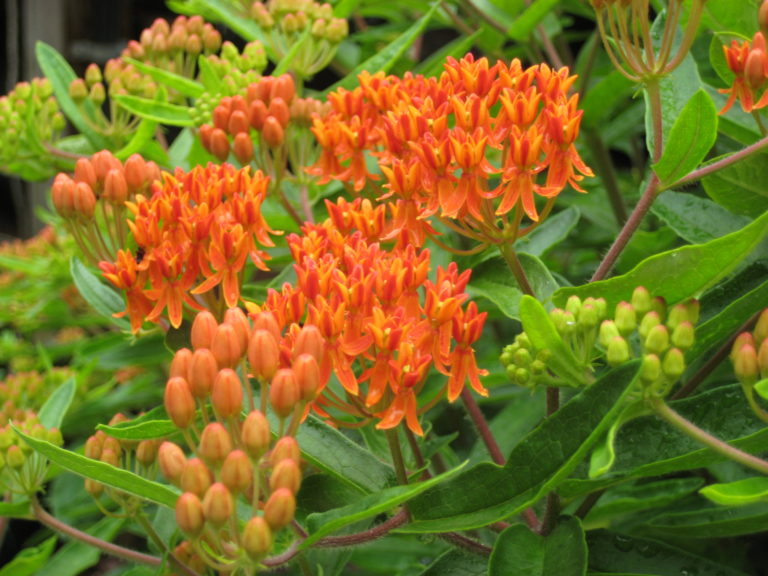Butterfly Weed, famous for its relationship to the endangered and beloved Monarch butterfly, nevertheless deserves a place in a perennial garden purely on aesthetic merits. It is a sun-loving, 1-2-ft, mound-shaped plant with dark green foliage and contrasting, bright orange, long-lasting flower clusters. These, in time, produce lovely pods of silky-threaded seeds which are carried by wind. In addition to providing foliage to feed the larvae of the Monarch, its flowers are also nectar sources for many other species of butterflies as well as for bees and other insects. Butterfly Weed has a deep taproot, and so is not easily transplanted. This root material was used in the past to treat Pleurisy, accounting for one of its common names. Butterfly Weed may seed out some, if seeds are not collected first. This member of the genus does not exude latex when cut as other milkweeds do. It is a roadside inhabitant, and appears to be deer resistant as well as drought tolerant. It is native to most of our states, and within NC it is reported to occur in all counties but one.
NURSERY HOURS
Wednesday: 10-4 Thursday: 10-6 Friday-Saturday: 10-4 Sunday: 12-4
Asclepias tuberosa

Key Info
Scientific Name: Asclepias tuberosa L.
Common Names: Butterfly Milkweed, Butterfly Weed, Orange Milkweed, Pleurisy Root, Chiggerplant
Family Names: Apocynaceae (Dogbane Family)
Plant Type: Herbaceous perennial
Flower Color: Orange
Additional Info
Habit: Upright perennial with deep taproot
Height: 1'-3'
Spread: 1'-2'
Soil Conditions: Prefers well drained, sandy soil; drought tolerant.
Leaves: Alternate arrangement of medium to dark green, lance-shaped, sessile, pointed, somewhat leathery leaves with lighter pubescent texture below.
Flowers (or reproductive structures: Umbels of long-lasting, bright orange, small 5-parted flowers at the tips of the stems.
Fruit: In fall, flowers have matured into erect, dehiscent brownish-red seed pods. These split open to release dry, flattened seeds attached to silken tails for wind transport.
Natural Distribution: Prairies, roadsides, open woodlands
USDA Hardiness Zone: 3 to 9
Pollination: Bees, butterflies, other insects
Wildlife Connections: Butterflyweed is a larval host for Grey Hairstreaks, Monarchs, Queens; nectar sources for butterflies, native bees, bumble bees, honey bees, and various beneficial insects.
Propagation: By seed or by root cuttings. Collect seeds when pod is mature (in late summer/early fall) but not yet split open. Root cuttings are also used.
